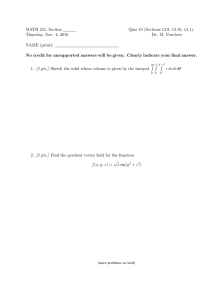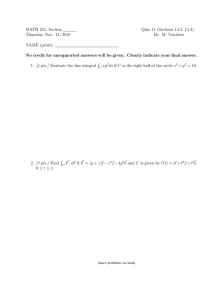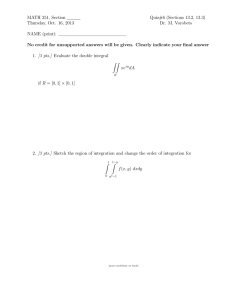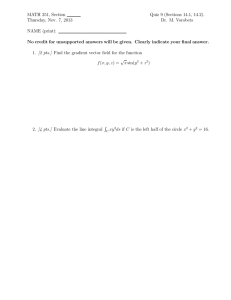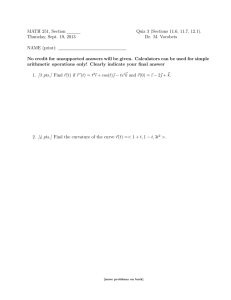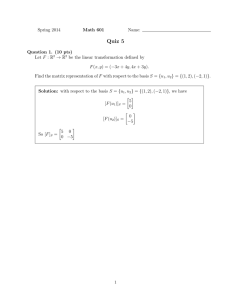18.02 Final Exam
advertisement
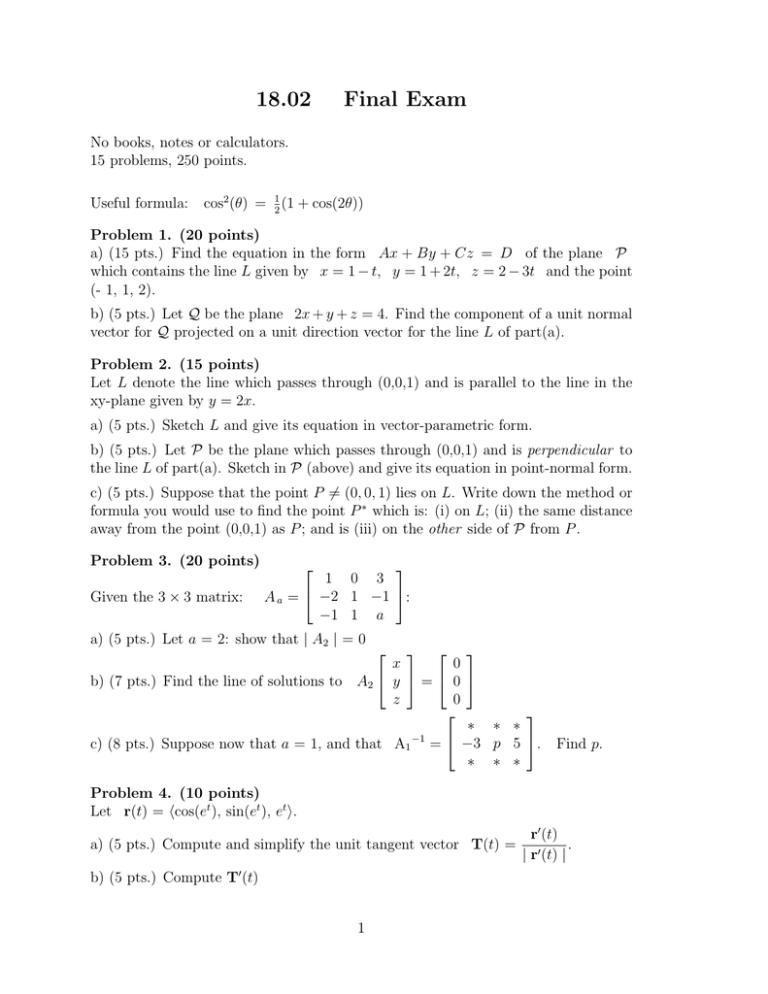
18.02 Final Exam No books, notes or calculators. 15 problems, 250 points. Useful formula: cos2 (θ) = 12 (1 + cos(2θ)) Problem 1. (20 points) a) (15 pts.) Find the equation in the form Ax + By + Cz = D of the plane P which contains the line L given by x = 1 − t, y = 1 + 2t, z = 2 − 3t and the point (- 1, 1, 2). b) (5 pts.) Let Q be the plane 2x + y + z = 4. Find the component of a unit normal vector for Q projected on a unit direction vector for the line L of part(a). Problem 2. (15 points) Let L denote the line which passes through (0,0,1) and is parallel to the line in the xy-plane given by y = 2x. a) (5 pts.) Sketch L and give its equation in vector-parametric form. b) (5 pts.) Let P be the plane which passes through (0,0,1) and is perpendicular to the line L of part(a). Sketch in P (above) and give its equation in point-normal form. c) (5 pts.) Suppose that the point P = � (0, 0, 1) lies on L. Write down the method or formula you would use to find the point P ∗ which is: (i) on L; (ii) the same distance away from the point (0,0,1) as P ; and is (iii) on the other side of P from P . Problem 3. (20 points) ⎡ Given the 3 × 3 matrix: ⎤ 1 0 3 A a = ⎣ −2 1 −1 ⎦: −1 1 a a) (5 pts.) Let a = 2: show that | A2 | = 0 ⎡ ⎤ ⎡ ⎤ x 0 b) (7 pts.) Find the line of solutions to A2 ⎣ y ⎦ = ⎣ 0 ⎦ z 0 ⎡ ⎤ ∗ ∗ ∗ c) (8 pts.) Suppose now that a = 1, and that A1 −1 = ⎣ −3 p 5 ⎦. ∗ ∗ ∗ Find p. Problem 4. (10 points) Let r(t) = �cos(et ), sin(et ), et �. a) (5 pts.) Compute and simplify the unit tangent vector T(t) = b) (5 pts.) Compute T� (t) 1 r� (t) . | r� (t) | Problem 5. (20 points) � y Consider the function F (x, y, z) = z x2 + y + 2 : z a) (10 pts.) The point P0 : (1, 3, 2) lies on the surface F (x, y, z) = 7. Find the equation of the tangent plane to the surface F = 7 at P0 . b) (5 pts.) If starting at P0 a small change were to be made in only one of the variables, which one would produce the largest change (in absolute value) in F ? If the change is this variable was of size 0.1, approximately how large would the change in F be ? c) (5 pts.) What distance from P0 in the direction ±�−2, 2, −1� will produce an approximate change in F of size 0.1 units, according to the (already computed) lin­ earization of F ? Problem 6. (15 points) 2 Let f (x, y) = x + 4y + . xy a) (10 pts.) Find the critical point(s) of f (x, y) b) (5 pts.) Use the second-derivative test to test the critical point(s) found in part(a). Problem 7. (10 points) Let P be the plane with equation Ax + By + Cz = D and P0 = (x0 , y0 , z0 ) be a point which is not on P. Use the Lagrange multiplier method to set up the equations satisfied by the point (x, y, z) on P which is closest to P0 . (Do not solve.) Problem 8. (15 points) √ a) (10 pts.) Let F (x, y, z) be a smooth function of three variables for which �F (1, −1, 2) = �1, 2, −2�. ∂F Use the Chain Rule to evaluate at (ρ, φ, θ) = (2, π4 , − π4 ). ∂φ (Use x = ρ sin φ cos θ, y = ρ sin φ sin θ, z = ρ cos φ.) b) (5 pts.) Suppose f (x, y) is a smooth, non-constant function. Is it possible that, for all points (x, y), the gradient of f at the point (x, y) is equal to the vector �−y, x� ? Justify (briefly). Problem 9. (10 points) �� � 2 � 2√2x f dA = f (x, y) dy dx . R 0 x2 a) (5 pts.) Sketch the region R. b) (5 pts.) Rewrite the double integral as an iterated integral with the order inter­ changed. 2 Problem 10. (15 points) �� Set up the integral f (x, y) dA where R is the region bounded by the four curves R x2 y = 4, x2 y = 9, xy = 1, and xy = 2 as a double integral in the variables u = x2 y and v = xy . (Your answer should be completely ready to integrate, once the function f is given.) 1 1 1 2 Note: the inverse transformation is given by x = u 3 v − 3 , y = u 3 v 3 . Problem 11. (15 points) F(x, y) = x (i + j), and let C be the closed curve in the xy-plane formed by the triangle with vertices at the origin and the points (1,0) and (0,1). a) (5 pts.) Give a rough sketch of the field F in the first quadrant, and use it to predict whether the net flux out of the region R = the interior of C will be positive or negative. � b) (5 pts.) Compute the flux integral F · n̂ ds directly. C (Specify which orientation you are using for C.) � c) (5 pts.) Compute the flux integral F · n̂ ds using the appropriate double C integral. (Set up, then using short-cut is ok.) Problem 12. (20 points) � Let G be the solid 3-D cone bounded by the lateral surface given by z = 2 x2 + y 2 and by the plane z = 2. The problem is to compute z̄ = the z-coordinate of the center of mass of G, in the case where the density is equal to the height above the xy-plane. a) (5 pts.) Find the mass of G using cylindrical coordinates (b) (5 pts.) Set up the calculation for z̄ using cylindrical coordinates (Answers should be ready to integrate out – but do not evaluate.) (c) (10 pts.) Set up the calculation for z̄ using spherical coordinates. (Answers should be ready to integrate out – but do not evaluate.) Problem 13.� (15 points) � � � F(x, y, z) = y + y 2 z i + (x − z + 2xyz) j + −y + xy 2 k a) (3 pts.) Show that F(x, y, z) is a gradient field using the derivative conditions. b) (10 pts.) Find a potential function f (x, y, z) for F(x, y, z), using any systematic method. Show the method used and all work clearly. � c) (2 pts.) Find F · dr, where C is the straight line joining the points (2, 2, 1) and C (1, -1, 2) (in that order), using as little computation as possible. 3 Problem 14. (25 points) In this problem S is the surface given by the quarter of the right-circular cylinder centered on the z-axis, of radius 2 and height 4, which lies in the first octant. The field F(x, y, z) = x i. a) (5 pts.) Sketch the surface S and the field F. (Suggestion: use a coordinate system with y pointing out of the paper.) �� b) (10 pts.) Compute the flux integral F · n̂ dS. S (Use the normal which points ’outward’ from S, i.e. on the side away from the z-axis.) c) (5 pts.) G be the 3D solid in the first octant given by the interior of the quarter cylinder defined above. Use the divergence theorem to compute the flux of the field F = x i out of the region G. d) (5 pts.) The boundary surface of G is comprised of S together with four other faces. What is the flux outward through these four faces, and why ? Use the answers to parts(b) and (c), and also verify using the sketch of part(a). Problem 15. (25 points) F(x, y, z) = (yz) i + (−xz) j + k. Let S be the portion of surface of the paraboloid z = 4 − x2 − y 2 which lies above the first octant; and let C be the closed curve C = C1 + C2 + C3 , where the curves C1 , C2 and C3 are the three curves formed by intersecting S with the xy, yz and xz planes respectively (so that C is the boundary of S). Orient C so that it is traversed CCW when seen from above in the first octant. � a) (15 pts.) Use Stokes’ Theorem to compute the loop integral F · dr by using C the surface integral over the capping surface S. � F · dr directly by parametriz­ b) (10 pts.) Set up and evaluate the loop integral C ing each piece of the curve C and then adding up the three line integrals. 4 MIT OpenCourseWare http://ocw.mit.edu 18.02SC Multivariable Calculus Fall 2010 For information about citing these materials or our Terms of Use, visit: http://ocw.mit.edu/terms.
